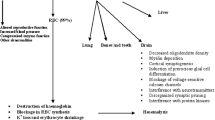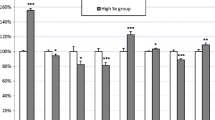Summary
The relationship between FEP and the indicators of dose (PbB, PbU, PbU-EDTA) was examined in a group of male subjects who had left lead-exposing jobs more than 12 months previously.
In these subjects, FEP and PbB and FEP and PbU were correlated to a distinctly lower degree compared to previous findings in currently exposed subjects, although the correlations were still statistically significant. In the previously exposed subjects the erythrocyte metabolite displayed definitely higher values than those found in currently exposed subjects at the same PbB or PbU levels.
A very close correlation was found between FEP and PbU-EDTA, as was found in exposed subjects. The regression curve assumed an identical profile in the two situations. From these results it may be concluded that FEP persists at high levels for a long time after cessation of exposure due to a direct inhibition of heme synthetase caused by lead released from the tissue deposits.
It should be noted that FEP proved to be a valid test for predicting the amount of lead storage, even a long time after cessation of exposure.
Similar content being viewed by others
Abbreviations
- PbB:
-
blood lead (μg/100 ml)
- PbU:
-
lead in urine (μg/l)
- PbU-EDTA:
-
amount of chelatable lead excreted with 24 h urine after administration of Ca NA2 EDTA (1 g intravenously)
- FEP:
-
free erythrocyte protoporphyrin (μg/100 ml RBC)
- ALAU:
-
urinary delta-aminolevulinic acid (mg/l)
- CPU:
-
urinary coproporphyrin (μg/l)
References
Albahary, C.: Lead and hemopoiesis. The mechanism and consequences of erythropathy of occupational lead poisoning. Amer.J.Med. 52, 367–378 (1972)
Alessio, L., Bertazzi, P.A., Toffoletto, F., Foà, V.: Free erythrocyte protoporphyrin as an indicator of biological effect of lead in adult males. I. Relationship between free erythrocyte protoporphyrin and indicators of internal dose. Int.Arch.Occup.Environ.Hlth 37, 73–88 (1976)
Andreoletti, F., Griffini, A., Colombo, G., Zurlo, N.: Détermination du plomb dans le sang par analyse spectrophotométrique à absorption atomique. In: Environmental health aspects of lead. Int.Symp., Amsterdam, 1972, p. 1071. Luxemburg: Comm.Europ.Commun. 1973
Baloh, R.W.: Laboratory diagnosis of increased lead absorption. Arch.environm.Hlth 28, 198–208 (1974)
Cantarow, A., Trumper, H.: Lead poisoning. Baltimore, Md.: Williams and Williams 1944
Farina, G., Alessio, L.: Ripetuti episodi di intossicazione saturnina comparsi a distanza di tempo dalla esposizione professionale a piombo. Med.d.Lavoro 64, 358–362 (1973)
Gajdos, A.: Le turbe del metabolismo delle porfirine nell'intossicazione da piombo. Folia Medica 40, 1–14 (1957)
Kehoe, R.A.: Misuse of edathamil calcium-disodium for prophylaxis of lead poisoning. J.Amer.med.Ass. 157, 341–342 (1955)
Pecora, L., Fati, S., Vecchione, C.: Patogenesi delle turbe porfiriniche nel saturnismo. Folia Medica 43, 685–695 (1960)
Prěrovská, I., Teisinger, J.: Excretion of lead and its biological activity several years after termination of exposure. Brit.J.industr.Med. 27, 352–355 (1970)
Rubino, G.F., Prato, V., Fiorato, L.: Erythrocyte copper and porphyrins in the lead poisoning. Brit.J.Haemat. 4, 103–107 (1958)
Saita, G., Moreo, L., Fabiani, A.: Studio sulle porfirine nel sangue periferico nel saturnismo. Med.d.Lavoro 45, 293–299 (1954)
Schlegel, H., Kufner, G., Leinberger, H.: Das Verhalten verschiedener Parameter der Hämsynthesestörung am Menschen bei experimenteller Aufnahme anorganischer Bleiverbindungen. In: Environmental health aspects of lead. Int.Symp., Amsterdam, 1972, p. 569. Luxemburg: Comm.Eyrop.Commun. 1973
Schwartz, S.: Studies, of porphyrin metabolisms — The effect of metals on coproporphyrin excretion. In: Toxicology of uranium (A. Tannebaum, ed.), pp. 290–326. New York: McGraw-Hill 1951
Schwartz, S., Wikoff, H.M.: The relation of erythrocyte coproporphyrin and protoporphyrin to erythropoiesis. J.biol.Chem. 194, 563–573 (1952)
Teisinger, J., Lustine, C.K., Srobova, J.: Effects of edathamil calciumdisodium on retention of lead in the liver. Brit.J.industr.Med. 17, 302 (1958)
Teisinger, J., Srobová, J.: The value of mobilization of lead by calcium ethylene-diamine-tetra-acetate in the diagnosis of lead poisoning. Brit.J. industr.Med. 16, 148–152 (1959)
Zurlo, N., Griffini, A.M., Colombo, G.: Determination of lead in urine by atomic absorption spectrophotometry after coprecipitation with thorium. Analytica Chimica Acta 47, 203–208 (1969)
Author information
Authors and Affiliations
Rights and permissions
About this article
Cite this article
Alessio, L., Bertazzi, P.A., Monelli, O. et al. Free erythrocyte protoporphyrin as an indicator of the biological effect of lead in adult males. Int. Arch. Occup. Environ. Hlth 38, 77–86 (1976). https://doi.org/10.1007/BF00378618
Received:
Accepted:
Issue Date:
DOI: https://doi.org/10.1007/BF00378618




